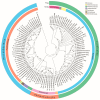Diversity of Antifungal Properties in Bacterial Isolates from Different Plant Species Growing Across Uzbekistan
- PMID: 40431332
- PMCID: PMC12114544
- DOI: 10.3390/microorganisms13051161
Diversity of Antifungal Properties in Bacterial Isolates from Different Plant Species Growing Across Uzbekistan
Abstract
Plant-associated bacteria play a crucial role in protecting plants from pathogens, yet the diversity and antagonistic potential of these bacteria across different plant species remain underexplored, especially in central Asia. To investigate the competitive dynamics between phytopathogenic fungi and plant-associated bacteria, we collected stem and root samples from 50 plant species across nine regions of Uzbekistan. A total of 3355 bacterial isolates were obtained (1896 from roots and 1459 from shoots) and screened for antifungal activity against six fungal pathogens, resulting in 432 antagonistic isolates. These were identified through 16S rDNA sequencing, revealing 65 bacterial species across three phyla: Firmicutes, Proteobacteria, and Actinobacteria, predominantly in the respective families Bacillaceae, Pseudomonadaceae, and Caryophanaceae. The plant Salsola vvedenskii hosted the highest diversity of antagonists (26 species), while other species harbored fewer. Plant species showed strong associations with specific bacterial communities, with 14 plant species each hosting unique antagonists. Enzymatic profiling revealed functional diversity, with Bacillus species producing protease, cellulase, and lipase activities, while Pseudomonas species excelled in xylanase, glucanase, and cellobiase production. B. mojavensis 9r-29 stood out by producing all six enzymes. These findings underscore the ecological diversity and biocontrol potential of plant-associated bacteria in natural ecosystems, offering promising candidates for sustainable plant protection strategies.
Keywords: antagonistic bacteria; antifungal activity; biocontrol; enzymatic activities; plant pathogens.
Conflict of interest statement
The authors declare that they have no competing interests.
Figures







Similar articles
-
Endophytic bacterial communities in ginseng and their antifungal activity against pathogens.Microb Ecol. 2007 Aug;54(2):341-51. doi: 10.1007/s00248-007-9208-3. Epub 2007 May 11. Microb Ecol. 2007. PMID: 17492474
-
Endophytic bacterial communities of field-grown potato plants and their plant-growth-promoting and antagonistic abilities.Can J Microbiol. 2004 Apr;50(4):239-49. doi: 10.1139/w03-118. Can J Microbiol. 2004. PMID: 15213748
-
Plant beneficial traits of endophytic bacteria associated with fennel (Foeniculum vulgare Mill.).AIMS Microbiol. 2024 Jun 18;10(2):449-467. doi: 10.3934/microbiol.2024022. eCollection 2024. AIMS Microbiol. 2024. PMID: 38919721 Free PMC article.
-
Insect-derived bacteria as biocontrol tool and a potent suppressor of plant pathogenic fungi in tomato cultivation.Microb Pathog. 2025 Jan;198:107158. doi: 10.1016/j.micpath.2024.107158. Epub 2024 Nov 26. Microb Pathog. 2025. PMID: 39608512
-
Fungal Root Microbiome from Healthy and Brittle Leaf Diseased Date Palm Trees (Phoenix dactylifera L.) Reveals a Hidden Untapped Arsenal of Antibacterial and Broad Spectrum Antifungal Secondary Metabolites.Front Microbiol. 2017 Feb 28;8:307. doi: 10.3389/fmicb.2017.00307. eCollection 2017. Front Microbiol. 2017. PMID: 28293229 Free PMC article.
References
-
- Wei X., Xie B., Wan C., Song R., Zhong W., Xin S., Song K.D. Enhancing soil health and plant growth through microbial fertilizers: Mechanisms, benefits, and sustainable agricultural practices. Agronomy. 2024;14:609. doi: 10.3390/agronomy14030609. - DOI
Grants and funding
LinkOut - more resources
Full Text Sources

